XFX’s Radeon HD 7970 Black Edition Double Dissipation: The First Semi-Custom 7970
by Ryan Smith on January 9, 2012 6:00 AM ESTThe Test, Power, Temp, & Noise
| CPU: | Intel Core i7-3960X @ 4.3GHz |
| Motherboard: | EVGA X79 SLI |
| Chipset Drivers: | Intel 9.2.3.1022 |
| Power Supply: | Antec True Power Quattro 1200 |
| Hard Disk: | Samsung 470 (240GB) |
| Memory: | G.Skill Ripjaws DDR3-1867 4 x 4GB (8-10-9-26) |
| Video Cards: |
XFX Radeon HD 7970 Black Edition Double Diss. AMD Radeon HD 7970 AMD Radeon HD 6990 AMD Radeon HD 6970 AMD Radeon HD 6950 AMD Radeon HD 5870 AMD Radeon HD 5850 AMD Radeon HD 4870 NVIDIA GeForce GTX 590 NVIDIA GeForce GTX 580 NVIDIA GeForce GTX 570 NVIDIA GeForce GTX 470 NVIDIA GeForce GTX 285 |
| Video Drivers: |
NVIDIA ForceWare 290.36 Beta AMD Catalyst Beta 8.921.2-111215a |
| OS: | Windows 7 Ultimate 64-bit |
We’ll start things in reverse today by first looking at the power, temperature, & noise characteristics of the 7970 BEDD. The custom cooler is the single biggest differentiating factor for the BEDD, followed by its factory overclock.
| Radeon HD 7900 Series Voltages | ||||
| Ref 7970 Load | Ref 7970 Idle | XFX 7970 Black Edition DD | ||
| 1.17v | 0.85v | 1.17v | ||
As we noted in our introduction, the BEDD ships at the same voltage as the reference 7970: 1.17v. Since XFX is using the AMD PCB too, the power characteristics are virtually identical, save for the overclock and the power draw of the two fans.
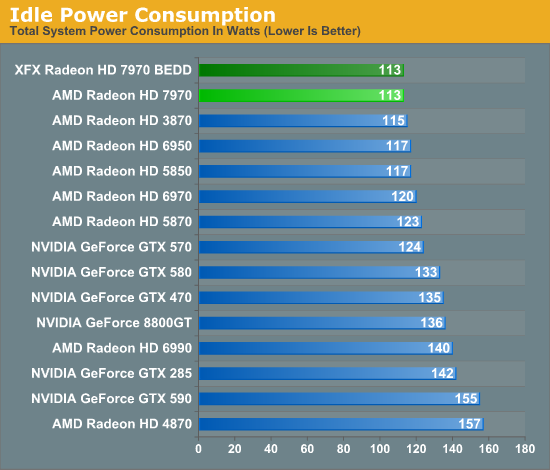
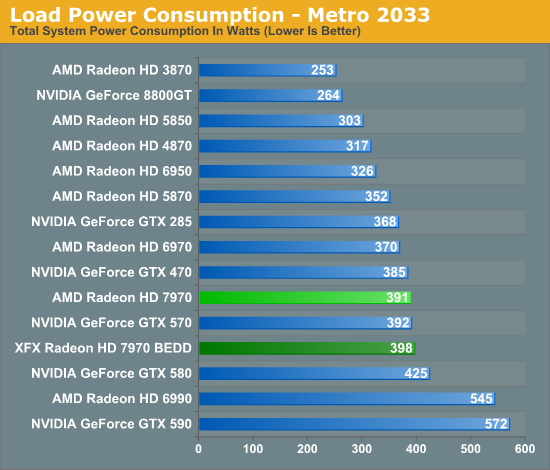
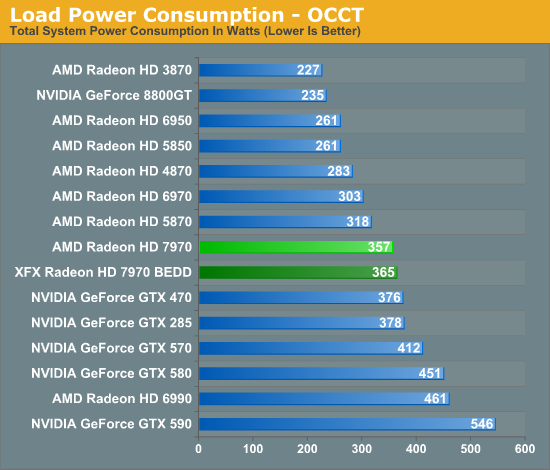
Even with two fans the idle power consumption of the BEDD is identical to the reference 7970. Meanwhile under load we see that the power consumption for the BEDD creeps up slightly compared to the reference 7970. With Metro 2033 we see system power consumption peak at 398W, 7W over the reference card, meanwhile under OCCT system power consumption peaks at 365W, 8W over the reference card.
It’s worth noting that as XFX has not touched the PowerTune limits for the BEDD, it’s capped at the same 250W limit as the reference 7970 by default. So far we haven’t seen any proof that the BEDD is being throttled at this level under any of our games or compute benchmarks, however we can’t completely rule this out as we still don’t have any tools that can read the real clockspeed of the 7970 when PowerTune throttling is active. Whenever an overclock is involved there’s always a risk of hitting that PowerTune limit before a card can fully stretch its legs, hence the need to be concerned about PowerTune if it hasn’t already been adjusted. As for our power tests, the difference seems to largely boil down to the higher power consumption of XFX’s fans when they’re operating above idle.

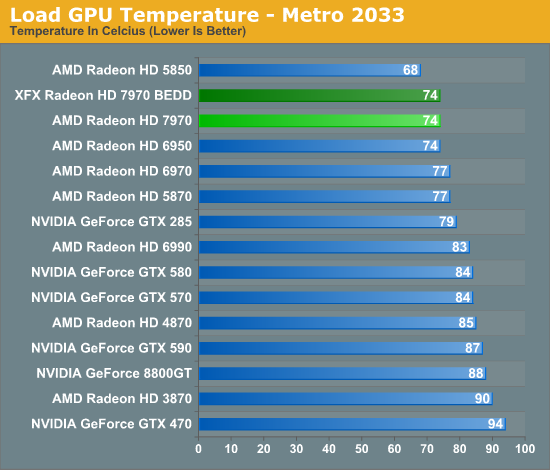
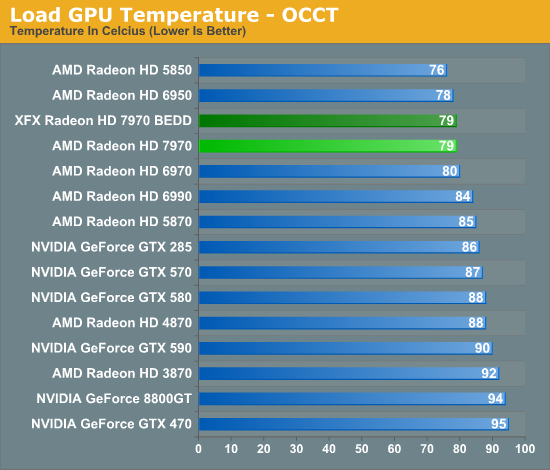
One of the key advantages of open air designs is that they do a better job of dissipating heat from the GPU, which is what we’re seeing here with the BEDD under idle. At 30C the BEDD is 4C cooler than the reference 7970, with all of that being a product of the Double Dissipation cooler.
However it’s interesting to note that temperatures under load end up being identical to the reference 7970. The BEDD is no cooler than the reference 7970 even with its radically different cooling apparatus. This is ultimately a result of the fact that the BEDD is a semi-custom card; not only is XFX using AMD’s PCB, but they’re using AMD’s aggressive fan profile. At any given temperature the BEDD’s fans ramp up to the same speed (as a percentage) as AMD’s fans, meaning that the BEDD’s fans won’t ramp up until the card hits the same temperatures that trigger a ramp-up on the reference design. As a result the BEDD is no cooler than the reference 7970, though with AMD’s aggressive cooling policy the reference 7970 would be tough to beat.
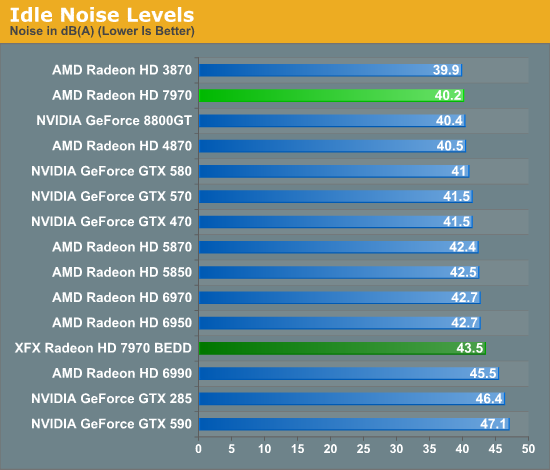
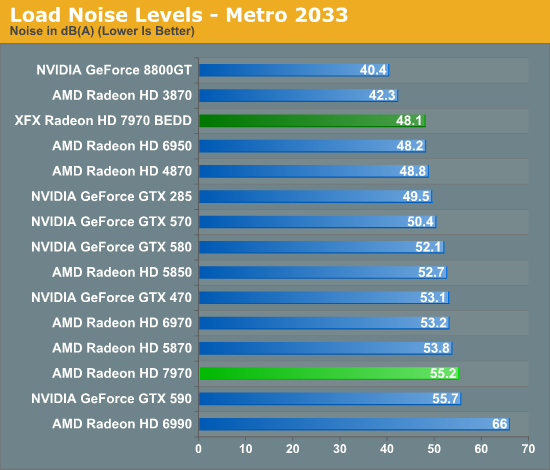
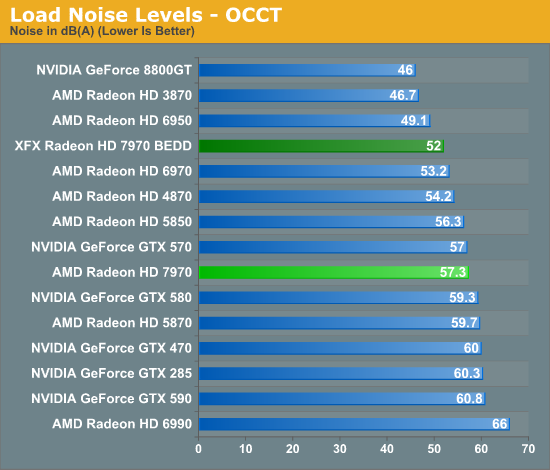
Finally taking a look at noise we can see the full impact of XFX’s replacement cooler. For XFX this is both good and bad. On the bad side, their Double Dissipation cooler can’t match the 7970 reference cooler when idling; 43.5dB isn’t particularly awful but it’s noticeable, particularly when compared to the reference 7970. Consequently the BEDD is definitely not a good candidate for a PC that needs to be near-silent at idle.
On the flip side under load we finally see XFX’s cooler choice pay off. AMD’s aggressive fan profile made the reference 7970 one of the loudest single-GPU cards in our lineup, but XFX’s Double Dissipation cooler fares significantly better here. At 48.1dB under Metro it’s not only quieter than the reference 7970 by a rather large 7dB, but it’s also quieter than every other modern high-end card in our lineup, effectively tying with the reference 6950. Even under our pathological OCCT test it only reaches 52dB, 5dB quieter than the reference 7970.
Ultimately where the BEDD was a poor candidate for noise under idle, it’s an excellent candidate for a quiet computer under load thanks to the open air nature of XFX’s Double Dissipation cooler, and certainly the launch card to get if you want a load-quiet 7970. Just don’t throw it directly up against another card in CrossFire, as these open air cards typically fare poorly without an open slot to work with.










93 Comments
View All Comments
chizow - Tuesday, January 10, 2012 - link
Also to this:"Gtx 460 and 560 ti were failure compared to AMD's offerings - in terms of performance."
Contradict yourself much? If this is true, then you're admitting every single GPU AMD has created since G80 is a failure compared to Nvidia's offerings and directly contradicting the points you're trying to make with regard to price and performance.
Sorry, you can't argue out of both sides of your mouth, the message just comes out a big jumbled mess.
wifiwolf - Tuesday, January 10, 2012 - link
I think with this post you're just saying he was right all along.And I agree. It's just business, you just choose where you you want to place your product: On profits or brand.
chizow - Tuesday, January 10, 2012 - link
No, I don't agree with any of that because its clearly off-base and out of place in a discussion about high-end performance parts.What drives pricing in this segment? This is a simple answer.
Performance. That's all that matters.
Performance/watt and performance/dollar are just tertiary considerations that take a back seat to secondary considerations like feature sets and application support. You win these "value" market segments not because you want to, but because you have to when you can't win without compromises.
wumpus - Tuesday, January 10, 2012 - link
DPFlops/Watt matters if Fermi and Kepler were designed for GPU computing. Nvidia makes a ton of money there, and doesn't have to compete with AMD nearly as much as in graphics.DPFlops/Card seem to matter more. I suspect that DPFlops/Card matters most (due to IO issues) than DPFlops/$ (once known as machoflops, mostly for govt/academic epeenwaving).
Now that both companies appear to be designing for GPU computing, it will be interesting to see how they compare (even if the 7970 seems to be missing half of its DPFlops. I wonder if they managed to de-power the transistors if they are there).
chizow - Tuesday, January 10, 2012 - link
DPFLops/Watt discussions have a place, but not for desktop GPU parts branded GeForce or Radeon. If this were a Tesla part it'd be more meaningful.Nvidia cripples DP performance pretty badly on their GeForce parts starting with Fermi and I imagine they will do the same for Kepler. It also sounds like AMD is doing the same for Tahiti, but it will be some time before we have any idea if GCN is even directly competitive in real world GPU compute applications.
Benchmarks and synthetic tests look great, but its going to take quite a bit of effort for AMD to get any penetration in a HPC market Nvidia has clearly dominated. Nvidia basically had to create their own API and GPU compute market from scratch, so AMD has their work cut out for them to catch up.
Jediron - Wednesday, January 11, 2012 - link
No, not the Champions of the poor. But yes, Champions of the single core Videocard!GTX580, you lose.
Sure the ball lies in Nvidia camp now, no suprise there! The ball was in AMD's camp, and they scored; that is obvious.
Long live the red camp :-)
mhampton - Monday, January 9, 2012 - link
Page 2 of the article starts by listing the setup tested, and the CPU must be a misprint - as far as I know there is no "i7-3936". Presumably this should be 3960 or 3930 instead.know of fence - Monday, January 9, 2012 - link
The same 3936 misprint can be found here:http://www.anandtech.com/show/5261/amd-radeon-hd-7...
Ryan Smith - Monday, January 9, 2012 - link
Noted and fixed. Thank you.BenSides - Monday, January 9, 2012 - link
I agree with a poster above, who is apparently content running a single 5850 paired with the latest game releases. I have 2 5870's in crossfireX, in conjuction with an old i7 950 cpu. My benchmark results (Crysis) blow this new thing (7870) to hell.While not a gamer, benchmarking is a hobby of mine. Looking at the results here at Anandtech, it is reassuring to know that with the elderly cards I have, it seems there is nothing, at the present time, or looming on the horizon, which would make my graphics cards obsolete.
In short, until AMD or NVIDIA introduce some revolutionary new technology, you're fine with your current card(s), if the presented benchmarks are any indication. Seems to me that at the present time, NVIDIA and AMD are producing new graphics solutions which are just overclocked versions of *old* graphics solutions.